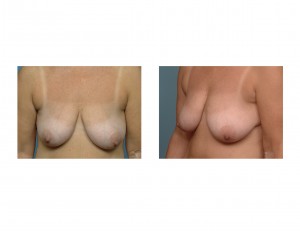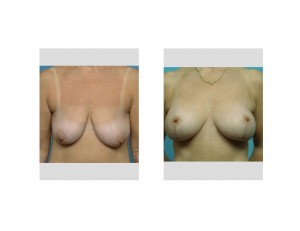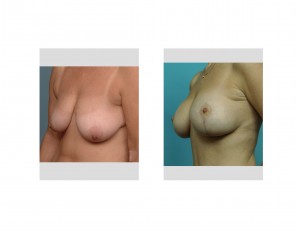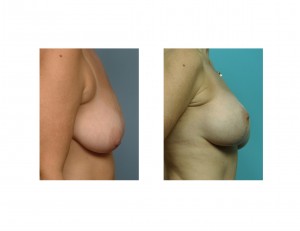Background: Breast augmentation remains one of the most commonly performed body contouring operations because it can successfully increase the size of a breast mound in a very short period of time. While the underlying implant makes the breast bigger, the final appearance of the breast is influenced by more than just the size and shape of the implant. The breast tissue that sits on top of the implant will effect the symmetry of the two mounds almost as much as the effect of the implant itself.
One of the key elements of the influence of one’s breast tissue on a breast augmentation result is the position of the nipple. While the nipple should be ideally positioned in the center of the breast mound, it often is not. The effects of pregnancy, weight loss and gravity frequently have the breast tissue sagging and the nipple low or even pointing downward over the lower breast fold. This poses problems for both the patient and the plastic surgeon alike. The hope of an uncomplicated solution by the placement of an implant alone is not going to work.
Known as ptosis, breast sagging has the greatest influence on breast augmentation results. An implant placed behind a sagging breast will only end up pushing the drooping breast tissue and nipple lower and giving the impression that the breast implant was placed too high. In the presence of breast sagging, implants must be done with some form of a breast lift. While there are four basic types of breast lifts, once the nipple is below the lower breast crease vertically directed types of breast lifts must be done. This results in scars that extend beyond the nipple, something that patients had hoped to avoid. Often this need completely surprises a patient as they had thought that an implant alone would solve the sagging breast problem.

Under general anesthesia, vertical breast lifts were initially performed. Known as the ‘lollipop’ breast lift, it is so called because of the final scar appearance. With a circular scar around the areola that then extends downward, it creates a scar pattern that resembles the shape of the candy. While this is the final closure pattern and shape of the scar, the pattern of the initial breast lift is a vertical skin cutout. With the shifting of the underlying breast mound and attached nipple to the top of the vertical cutout, the skin closure then creates this lollipop scar pattern.


1) Candidates for breast augmentation often present with sagging or breast ptosis. Implants alone will not create a significant lifting.
2) If the nipple is below the level of the lower breast crease/fold, a breast lift will be needed that creates scars that extend downward from the nipple into the fold.
3) Concurrently performed lifts with breast implant placement is a challenging operation that not infrequently may require a revision to optimize shape and symmetry between the two breasts.
Dr. Barry Eppley
Indianapolis, Indiana



